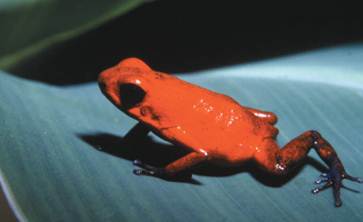


 النبات
النبات
 الحيوان
الحيوان
 الأحياء المجهرية
الأحياء المجهرية
 علم الأمراض
علم الأمراض
 التقانة الإحيائية
التقانة الإحيائية
 التقنية الحيوية المكروبية
التقنية الحيوية المكروبية
 التقنية الحياتية النانوية
التقنية الحياتية النانوية
 علم الأجنة
علم الأجنة
 الأحياء الجزيئي
الأحياء الجزيئي
 علم وظائف الأعضاء
علم وظائف الأعضاء
 الغدد
الغدد
 المضادات الحيوية
المضادات الحيوية|
Read More
Date: 14-10-2015
Date: 9-10-2015
Date: 26-10-2015
|
Amphibian
The class Amphibia consists worldwide of nearly 4,700 species, contained in three major orders: Caudata (salamanders), Gymnophiona (caecilians), and Anura (frogs and toads). Salamanders are composed of about 415 species worldwide, and are typically characterized by their long tails and four limbs of nearly equal size. They first appeared in the fossil record over 190 million years ago in the late Triassic.
The caecilians consist of about 165 species. They have a mostly pantrop- ical distribution, and are characterized by their elongated, annulated (ringed) bodies and lack of legs, resembling worms. These amphibians first appeared in the fossil record nearly 190 million years ago in the early Jurassic.
By far the most successful of the three orders with about 4,100 species worldwide, frogs and toads are characterized by lack of a true tail and by generally having comparatively enlarged hind limbs. The order Anura first surfaced in the fossil record about 230 million years ago in the early Triassic.
Amphibians have relatively moist, scaleless skin and rely heavily on cutaneous respiration and/or the presence of a buccopharyngeal pump (a muscular pump in the throat) to force air into their mouth and lungs, features not found in other classes of terrestrial vertebrates. In addition, most amphibians produce eggs that develop and hatch outside their bodies laying gelatinous, unshelled eggs in water or moist places. Many undergo a larval aquatic existence before metamorphosis into adults (unlike other classes of terrestrial vertebrates). In a few species, the female retains the eggs in her body where they are nourished directly by her before she gives birth to her young, or they develop by absorbing their own yolk (a phenomenon also known to occur in at least one species of sea snake, class Reptilia).

A strawberry poison arrow frog in Costa Rica.
Some populations of amphibians have disappeared or begun to decline, and this has raised concern among biologists worldwide. It is unknown if this phenomenon is uniformly widespread across all continents, or is occurring only in selected areas.
References
Halliday, Tim R., and Kraig Adler. The Encyclopedia of Reptiles and Amphibians. Facts on File, Inc., 1986.
Pough, F. Harvey, R. M. Andrews, J. E. Cadle, M. L. Crump, A. H. Savitzky, and K. D. Wells. Herpetology. Upper Saddle River, NJ: Prentice Hall, 1998.
Stebbins, Robert C., and Nathan W. Cohen. A Natural History of Amphibians. Princeton, NJ: Princeton University Press, 1995.



|
|
|
|
تفوقت في الاختبار على الجميع.. فاكهة "خارقة" في عالم التغذية
|
|
|
|
|
|
|
أمين عام أوبك: النفط الخام والغاز الطبيعي "هبة من الله"
|
|
|
|
|
|
|
قسم شؤون المعارف ينظم دورة عن آليات عمل الفهارس الفنية للموسوعات والكتب لملاكاته
|
|
|